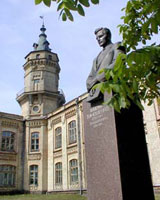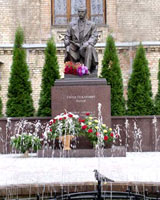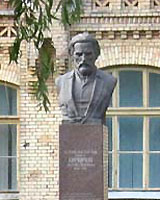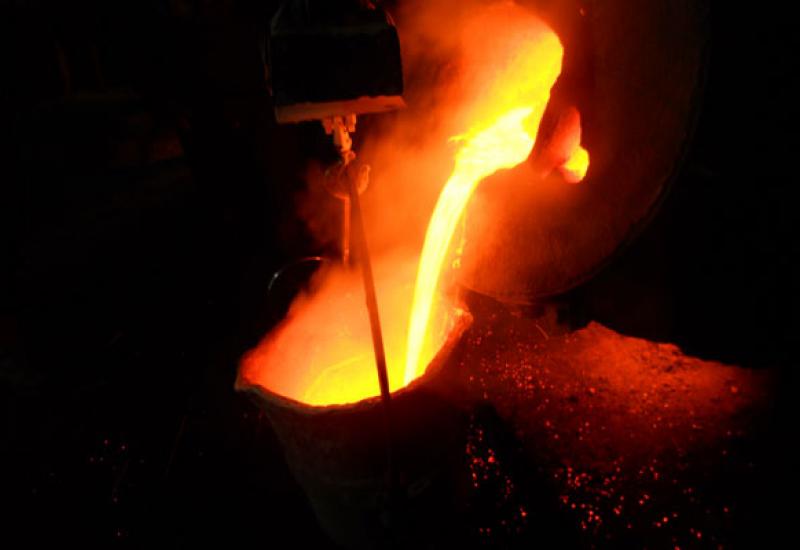Firstly, the metal come to people’s life as a need: tools, machines and mechanisms, decorations. The first products from alloys were appeared on the verge of coal and copper ages - V-VI BC. Over time, the fantasy of architects and designers directed to the artistic castings for decoration of parks, buildings and squares. A period of monumental commemorative sculptures came.
The seven most famous masterpieces of ancient cultures are called wonders of the world. Two of these are artistic castings. This – a bronze statue of the sun god Helios (Apollo), height of 35 m, which is called “Colossus of Rhodes” (built in 292-280 years BC), which was destroyed during an earthquake in 224 BC., and the statue of Zeus (Jupiter) Phidias (430 BC.) in Olympia, Greece, made from gold, marble and ivory, height of 12 m, which burned in fire.
The world of artistic casting has thousands of years. The most remarkable events and history’s individuals of any nation are reflected in artistic castings.
In 1998 Kyiv Polytechnic Institute celebrated the 100th anniversary of its founding. The first rector of the Kiev Polytechnic Institute was the head of the South Russian society of technologists Prof. VL Kirpichev. In September 1998 by the centennial of the KPI in memory of the first rector, a monument was erected in front of the main building of the Institute. At the same time, a monument to the outstanding scientists scientist Academician SP-Mechanics Timoshenko was opened to the public (sculptor N.M.Derehus).
 The University also pointed out that the first graduation of the specialists from four faculties was a century ago: from engineering, chemical, agricultural and construction faculties. The first head of the State Examination Commission of the Kyiv Polytechnic Institute in 1903 was a great scientist and chemist D.I.Mendelyeyev. His scientific and socio-political ties with Kyiv at that time were quite strong. Little known is the fact that D.I.Mendelyeyev stand for election to the St. Petersburg Academy of Sciences in 1880. The expression of civil courage was a proposal to elect D.I.Mendelyeyev as honorably member of the University of Kyiv, on the proposal of the head of the Kyiv Naturalists Society K.M.Feofilktov, who at that time was a rector, but soon dismissed from the position. Feofilaktov’s proposal was approved by vote of the Kyiv University and supported by similar action of other higher educational establishments.
The University also pointed out that the first graduation of the specialists from four faculties was a century ago: from engineering, chemical, agricultural and construction faculties. The first head of the State Examination Commission of the Kyiv Polytechnic Institute in 1903 was a great scientist and chemist D.I.Mendelyeyev. His scientific and socio-political ties with Kyiv at that time were quite strong. Little known is the fact that D.I.Mendelyeyev stand for election to the St. Petersburg Academy of Sciences in 1880. The expression of civil courage was a proposal to elect D.I.Mendelyeyev as honorably member of the University of Kyiv, on the proposal of the head of the Kyiv Naturalists Society K.M.Feofilktov, who at that time was a rector, but soon dismissed from the position. Feofilaktov’s proposal was approved by vote of the Kyiv University and supported by similar action of other higher educational establishments.
In 1999 to mark the great respect in front of the chemical block of the Kyiv Polytechnic Institute, the Mendelyeyev monument was opened to the public (sculptor V.V.Shvetsov). In 1994, on the initiative of the dean of the Faculty of Physical Engineering NTUU “KPI” Prof. A.P.Somyka at the Department of foundry of ferrous and nonferrous metals were discovered specialization “Artistic and jeweler casting”. Traditional training of engineers-casters expanded with new theoretical and practical courses:
- History of art casting and Art basics;
- Metallurgy of precious metals;
- Technology of shaping of the artistic casting;
- Metals, alloys and technologies of art and jewelry casting.
 Since that, the significance of this specialty highly increased. Many graduates apply their knowledge at the intersection of technology and art. And in the National Technical University with the efforts of management and employees of department of foundry manufacture of ferrous and nonferrous metals, in the KPI’s historic zone in the shade of trees at the back of the first building was created a cozy courtyard with fountain and benches ((architect S.N.Snyezhkin). Here were established cast monuments to known and honored scientists, who over the years worked in teaching and scientific field.
Since that, the significance of this specialty highly increased. Many graduates apply their knowledge at the intersection of technology and art. And in the National Technical University with the efforts of management and employees of department of foundry manufacture of ferrous and nonferrous metals, in the KPI’s historic zone in the shade of trees at the back of the first building was created a cozy courtyard with fountain and benches ((architect S.N.Snyezhkin). Here were established cast monuments to known and honored scientists, who over the years worked in teaching and scientific field.
Here in Kyiv in June 2002 the first monument to the founder of the national school of welding, Academician Paton, was opened to the public. He worked more than 30 years in the KPI. Before his monument’s establishment, existed only plaques. Then, in November 2002, a monument to Academician Lebedev was erected, which is also the only one in Kyiv. Under the guidance of Academician Lebedev the first computers were created in the country and Europe. In May 2003, the monument to outstanding mathematics and Academician M.P.Kravchuk was erected.
The casting of bronze Platon, Lebedev, Kravchuk monuments were carried out by creative teams on the basis of department of foundry manufacture of ferrous and nonferrous metals. All plaster models of sculptures were made by People’s Artist of Ukraine, corresponding member of the Academy of Arts, sculptor A.P.Skoblikov. In work were involved masters: molder Y.D.Lytvynenko, minter V.I.Cheremnyh and brightest students of this specialization.
 Artistic casting has become an important element of the architectural interior. Patinated bronze sculpture emphasizes the atmosphere of the past. It should be noted that compared to antiquity, today, and still casting production workflow has not changed. But technology of today is a pre-defined material properties, modern formative materials, industrial melting units and advanced methods of artificial aging of bronze. This draws attention to the history and art casting technology as an art. In 1540 Vanochio Byrynhuchio in his work "Pyrotechnics" wrote that the foundry work "... it is advantageous and fine craft and highly exciting."
Artistic casting has become an important element of the architectural interior. Patinated bronze sculpture emphasizes the atmosphere of the past. It should be noted that compared to antiquity, today, and still casting production workflow has not changed. But technology of today is a pre-defined material properties, modern formative materials, industrial melting units and advanced methods of artificial aging of bronze. This draws attention to the history and art casting technology as an art. In 1540 Vanochio Byrynhuchio in his work "Pyrotechnics" wrote that the foundry work "... it is advantageous and fine craft and highly exciting."
Nov 13, 2006 || By A.Kocheshkov, Associate Professor of foundry, Photo V.Ihnatovych.

